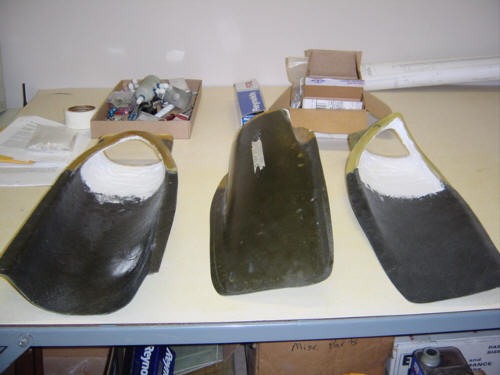

The Berkut uses three small scoops to catch enough fresh air to cool the cylinders, feed the fuel injector, and route through the oil cooler. There are two "arm-pit" scoops that mount on the lower cowl, and a central scoop mounted on the belly. All of these scoops come from the factory with a 3/8" thick leading edge and a lip on the aft side. This lip causes quite a bit of airflow turbulence and needs to be faired out to at least 7-degrees to make a smooth transition. According to Klaus Savier, as much as 5 knots can be gained with this simple modification - so I did it! Besides, it looks better anyway.
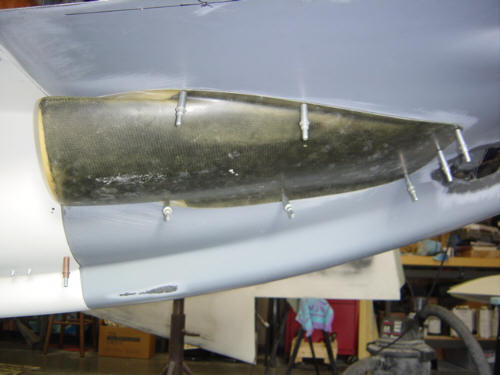
UPDATE 3-14-04: At this time, the engine is almost ready for it's first start - it's time to mount the "arm-pit" scoops and blisters on the cowls. This is very simple, thanks to Dave's molding techniques - the parts just fit first time out! I trimmed the excess material off the scoops and prepped the lower cowl to receive them and the blisters. In case you missed this in the other sections, I had to cut some relief holes in the cowls to make additional clearance for a few items - upper engine mount rings, the mixture linkage on the injector servo, and the alternator. No big deal, but they had to be done. Anyway, once the trimming is done, the scoops are floxed into position held in place with a few Clecos while setting up.
The blisters are very simple patches, actually. The only thing I had to do to the cowl is sand the areas around the holes. Inside the cowl, I used a small build up of material covered with packing tape as a release material. This I put a 2-ply patch (one ply BID carbon, one ply BID glass) over the hole. Not only does it cover the hole, it takes the shape of the material under it. Thus, making a blister on the cowl. One-ply BID glass is applied to the inside to finish things off after cure.
One very kewl by-product of installing the scoops is that the cowls now mate together perfectly!!! On both sides too!! This is really nice, since the only way I could get them to match up was to force them into position with clamps. Now...everything is locked into position and all is good! Next up...fairing the blisters.
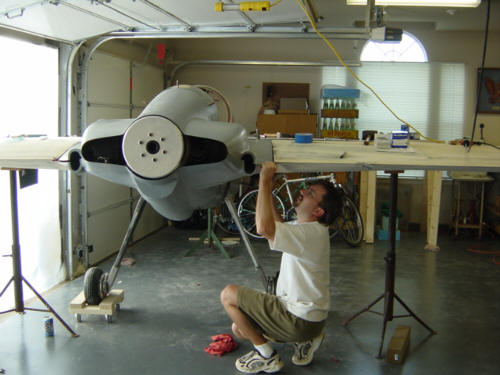
For those who might not know, the cowls are the carbon fiber covers that surround the engine and attach to both the wings and fuselage. They attach with screws and cam-locks and are removable for maintenance and inspections. They are also a major pain to install on just about any aircraft. Dave Ronneberg worked very hard to make the Berkut cowls as easy to install as possible - and, for the most part, succeeded. Here is how the process goes:
Prior to this procedure, the engine was installed and verified that it is on centerline at the tip of the prop extension. The spinner back-plate is put in place and the upper cowl placed on top of the engine and roughly in position then cleco'ed to the fuselage. It took very little trimming and positioning for the upper cowl on my plane...it simply fit...right out of the box (so to speak). Although the cowl is made of carbon fiber, it is still somewhat flexible. So, you want to put all the micro and flox for fairing the cowls to the wings onto the wing itself, not the cowl. To do that, the cowl is held in a slightly higher position that the wing surface with tongue depressors. Now remember, all of this process is a 'install, check-fit, wiggle, check-again, remove, trim and repeat' process. The objective is to use the forward edge of the spinner bulkhead as a reference, align the cowl so that the bulkhead is centered in the cowl hump with even spacing, AND at same time make sure all the angles and intersections line up with the trailing edge of the wings, the fuselage and...the lower cowl. These many variables are the reason why cowl install is so complicated and difficult to get just right.
Once the upper cowl is really in place, it is time to up the lower cowl into rough position. To make the cowl a little more flexible and easier to install, it is acceptable to go ahead and remove the cowl material where the armpit air scoops will be installed. Also, note the use of clamps to hold (or force) everything into a relative position with each other. At this point, I had spent several hours trying to get the lower cowl to fit properly. Even after a few calls to Dave, I could not seem to figure out what I was doing wrong. I would change one angle, and the other side would pop out of alignment and so on. Until it dawned on me that if all things were not equal...something was lying to me - the lower cowl just was not symmetrical. So, I decided to cut the internal stiffener rib and see if that was the problem. POW! As soon as I cut the stiffener everything suddenly lined up. That was the problem all along. Apparently, when the stiffener was added at the factory, it was slightly out of line and introduced a twist into the cowl which was throwing everything off. That 3/32-inch gap made all the difference in the world and all the angles mated perfectly!
With the cowl alignments finally in proper relation to everything, duct tape is applied to the interior surface of the cowl and 4 & 5 ply BID tapes are attached in the wing/cowl and strake/cowl inner borders. Once cured, these tabs are matched drilled with the cowls for future installation of mounting screws and cam-locks. Note there are both front and side tabs for cowl attachment. Once semi-cured, a single ply of BID is added from the exterior surfaces of the wings to the cowl tabs to add rigidity and the cowl is cleco'ed into position to 'squish' the tapes in place. Similar tape is added to the front tabs/spar intersection as well. While these tabs are still chemically active, micro is added to the wing/strake intersection, and the front cowl tabs. Flox is used at the intersection between the cowls and the wing to make the part line stronger so that it can stand up to the multiple install/de-installs of the cowls. This all will be sanded and faired in to match the cowl surface exactly - leaving an even, crisp part-line.
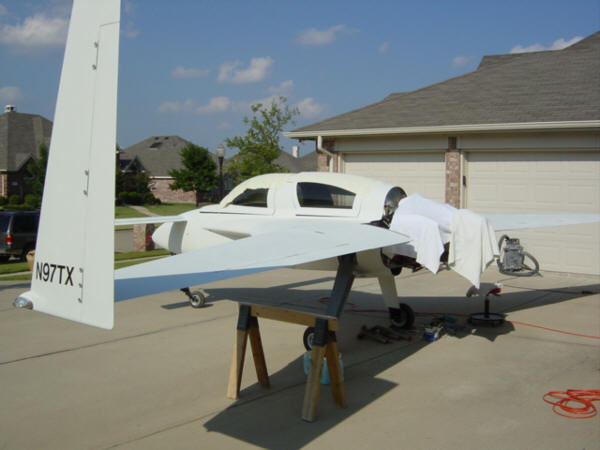
UPDATE 8-2-04: Well...not all of it was at night...but it was an all-nighter and all weekend! It was my birthday, and I wanted to just work on the plane...the way I used to...so, Sandy let me! Man, she is the best! Anyway, a few weeks ago, I installed the oil dipstick cowl door. It is just a 5-ply BID cover with a hinge...no biggie there. Back out in the sun, I quickly realized that I needed to remove the exhaust pipes so I could get into the inside of the aft cowl. After the sun went down, I put the cowls on and made up some 4-ply BID tapes. I put the tapes on the outboard aft angles and the inboard aft section. These tapes were half laid over packing tape as a mold release and will form tabs for attaching the two cowl halves together. I also repaired the lower stiffener that had to be cut to allow the cowls to fit. It's ugly, but it works. After the tabs had semi-cured, I put 1-ply BID from the exterior onto the tab - this will give more structural integrity to the tab. After complete cure, the new mounting points are drilled out and nut plates are installed.
UPDATE 8-12-04: OK, the plane has been moved, the inspection is tomorrow and I still have a lower cowl to do! ACK! First, let me catch you up. While in the comfort of the air-conditioned workshop, I installed the Cam-Loc receptacles in the wing root flanges for both the upper and lower cowls. I also installed the baffle seals around the upper and lower perimeter. Since the upper cowl was complete, I installed the exhaust heat shield material. It's the same stuff I used in the wing roots - Thermo-Tech Aluminized Heat Barrier. Great stuff! It's used all the time in Indy and other race cars - it's good to 2000-degrees F. When it was all said and done - I had a upper cowl.
The lower cowl was not as easy. With the arm-pit scoops and blisters, it was quite a challenge to contour sand the micro. After several hours, I FINALLY made it through the sanding. After several coats of primer and cam-loc fasteners - I have a lower cowl too. I also added heat shields to the lower cowl as well. Whew! The plane NOW has all it's parts and is ready for inspection...good thing too - it's tomorrow morning!
UPDATE 8-18-04: With everything now completed under the cowl, I decided to put them on and fully screw them down for the first time. Here is what they look like - side view and aft view. Of course, they are not finished, but they are mounted, shielded and ready to fly....as is the rest of the plane! C'mon transponder!!
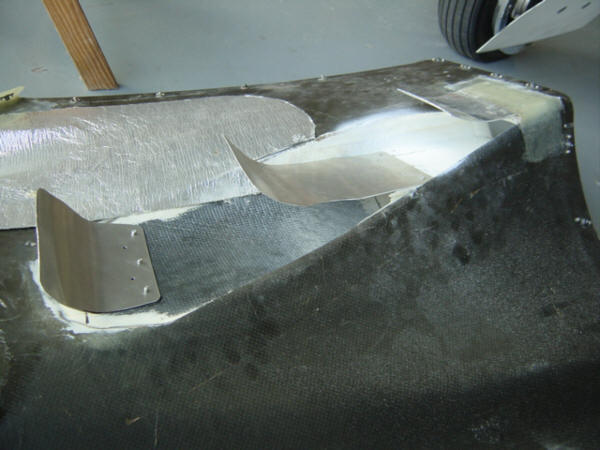
UPDATE 9-26-05: ...PUT COOLING TEXT HERE...
 Back to the Proto-page
Back to the Proto-page